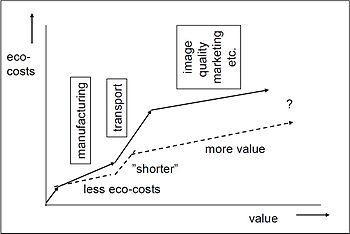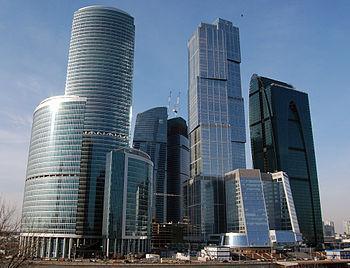
Español: Logotipo de la empresa estadounidense de cosméticos Avon Products, Inc. (Photo credit: Wikipedia)

English: Funmate Proctor & Gamble “Go Car”, 1971 Ford Torino with launcher. (Photo credit: Wikipedia)

Français : Logos ibm utilisés depuis 2009. Trademarked by International Business Machines Corporation. (Photo credit: Wikipedia)

Journal of International Business Studies (Photo credit: Wikipedia)

EORI-Strategy (Photo credit: Wikipedia)

Figure 4: Design strategies to enhance the EVR of a product. (Photo credit: Wikipedia)
The Strategy of International Business

English: Moscow-city 2010,March (Photo credit: Wikipedia)
Learning objectives
- Explain the concept of strategy.
- Recognize how firms can profit from expanding globally.
- Understand how pressures for cost reductions and pressures for local responsiveness influence strategic choice.
- Identify the different strategies for competing globally and their pros and cons.
- In this chapter the focus shifts from the environment to the firm itself and, in particular, to the actions managers can take to compete more effectively as an international business.
This chapter looks at how firms can increase their profitability by expanding their operations in foreign markets, the different strategies that firms pursue when competing internationally, and the various factors that affect a firm’s choice of strategy.
Subsequent chapters in the textbook discuss a variety of topics including: the design of organization structures and control systems for international businesses, strategies for entering foreign markets, the use and misuse of strategic alliances, strategies for exporting, and the various manufacturing, marketing, R&D, human resource, accounting, and financial strategies that international businesses pursue.
The opening case explores the evolution of Avon’s international strategy. Avon’s international sales dropped significantly in 2005, but after making several changes to its strategy, recent results have been much more promising. The closing case describes how IBM changed its strategy in foreign markets from a highly localized one to a more globally integrated approach.
OUTLINE OF CHAPTER 13: THE STRATEGY OF INTERNATIONAL BUSINESS
Opening Case: Avon Products
Introduction
Strategy and the Firm
Value Creation
Strategic Positioning
Operations: The Firm as a Value Chain
Global Expansion, Profitability and Growth
Expanding the Market: Leveraging Products and Competencies
Location Economies
Experience Effects
Leveraging Subsidiary Skills
Summary
Cost Pressures and Pressures for Local Responsiveness.
Pressures for Cost Reductions
Pressures for Local Responsiveness
Management Focus: Local Responsiveness at MTV Networks
Choosing a Strategy
Global Standardization Strategy
Localization Strategy
Transnational Strategy
International Strategy
The Evolution of Strategy
Management Focus: Vodafone in Japan
Management Focus: Evolution of Strategy at Proctor & Gamble
Chapter Summary
The opening case describes the evolution of Avon’s international strategy. The company, which relies on foreign sales for some 70 percent of its total revenues, saw its sales drop significantly beginning in 2005. The company, hurt by changes in regulations in China and economic weakness in Eastern Europe, Russia, and Mexico, was forced to completely revamp its international strategy. Thanks to the changes,

English: Perfume “Rouge”, created by french fashion designer Christian Lacroix, exclusively for Avon Products. Released in October 2007. Español: Botella de perfume “Rouge”, creado exclusivamente para Avon por el diseñador de modas francés Christian Lacroix. Lanzado en octubre de 2007. (Photo credit: Wikipedia)
Avon is now beginning to see an uptick in sales and revenues. Discussion of the case can revolve around the following questions:
1. How important are international sales to Avon? Why did the economic woes in Eastern Europe, Russia, and Mexico in the mid-2000s create so many problems for Avon? What does this tell you about the global economy and international strategy?
2. What type of strategy did Avon use prior to 2005? What type of strategy is Avon following today?
3. What are the advantages of Avon’s new strategy? Why was it essential to change the company’s strategy approach? Discuss the benefits of the new strategy, and also any shortcomings it may have.
To learn more about Avon and its operations in foreign markets go to {http://www.avoncompany.com/world/index.html}, and click on the individual markets. To learn about Avon’s recent strategy in developing countries go to {http://www.businessweek.com/news/2011-09-01/brics-no-cure-for-global-economic-growth-as-avon-shares-sink.html}.
LECTURE OUTLINE FOR CHAPTER
Strategy and the Firm
How can firms compete more effectively internationally?
A firm’s strategy can be defined as the actions that managers take to attain the goals of the firm.
Value Creation
If consumers perceive the value of a good to be much higher than the actual cost of producing that good, profit margins will be higher. Porter emphasizes two basic strategies to create value and attain competitive advantage: low cost strategy and differentiation strategy.
Strategic Positioning
Not all positions on the efficiency frontier are viable. Firms must choose a strategic position that is viable.
Firms often face resistance when they change their strategic course. To learn how to stay on track, consider {http://www.businessweek.com/managing/content/aug2010/ca20100810_373428.htm}.
Global Expansion, Profitability, and Profit Growth
Expanding globally allows firms to increase their profitability and rate of profit growth in ways not available to purely domestic enterprises.
Expanding the Market: Leveraging Products and Competencies
The success of firms that expand internationally depends on the goods or services they sell, and on their core competencies (skills within the firm that competitors cannot easily match or imitate).
Location Economies
Location economies are the economies that arise from performing a value creation activity in the optimal location for that activity.
Experience Effects
Experience effects are systematic reductions in production costs over the life of the product. The speed with which a firm moves down the experience curve will determine how much advantage it has over its competitors
Leveraging Subsidiary Skills
A global corporation can find vital skills developed in one foreign subsidiary and leverage them in another part of the world. In order to take advantage of subsidiary skills the company must have sophisticated processes that identify new skills that could be of interest. Once these skills are identified, managers must have the capability to transfer them elsewhere.
Managers need to keep in mind the complex relationship between profitability and profit growth when making strategic decisions about pricing.
Cost Pressures and Pressures for Local Responsiveness
Firms that compete in the global marketplace typically face two types of competitive pressures:
- pressures for cost reductions
- pressures to be locally responsive
Pressures for Cost Reduction
International businesses often face pressures for cost reductions because of the competitive global market.

Español: Crema de tratamiento antiedad AVON Anew Alternative. (Photo credit: Wikipedia)
Pressures for Local Responsiveness
Pressure for local responsiveness comes from differences in consumer tastes, infrastructure, distribution channels, or host government demands.
Slides 13-31-13-36 Choosing a Strategy
There are four basic strategies to compete in the international environment:
- global standardization
- localization
- transnational
- international
The global standardization strategy focuses on increasing profitability and profit growth by reaping the cost reductions that come from economies of scale, learning effects, and location economies.
The localization strategy focuses on increasing profitability by customizing the firm’s goods or services so that they provide a good match to tastes and preferences in different national markets.
The transnational strategy tries to simultaneously:
- achieve low costs through location economies, economies of scale, and learning effects
- differentiate the product offering across geographic markets to account for local differences
- foster a multidirectional flow of skills between different
The international strategy involves taking products first produced for the domestic market and then selling them internationally with only minimal local customization.
The Evolution of Strategy
Strategy is an evolutionary process. Firms need to change their strategic approach as the environment changes.
Related articles
- Russia Announces Deployment of Bombers Over the Gulf of Mexico

- Keep that antibacterial soap away, new Minnesota law states

- Brewer AB InBev hit by falling beer sales in Russia, U.S.

- NATO asks US for more troops in Baltic states, Poland to counter ‘Russia threat’


